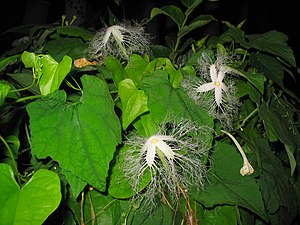Trichosanthes
| Trichosanthes | ||||||||||||
|---|---|---|---|---|---|---|---|---|---|---|---|---|

Snake hair cucumber ( Trichosanthes cucumerina ) |
||||||||||||
| Systematics | ||||||||||||
|
||||||||||||
| Scientific name | ||||||||||||
| Trichosanthes | ||||||||||||
| L. |
Trichosanthes is an Asian genus of the cucurbit family (Cucurbitaceae) with around 100 species. The snake hair cucumber is commercially important.
features

The representatives are small to large climbing plants, predominantly perennial , rarely annual . The tendrils are branched with 2 to 5, rarely up to 9 branches, only rarely are they simple. The plants are dioecious , more rarely monoecious .
The leaves are simple, whole or lobed or compound, then with 3 to 5 lobes. The leaf margin is scattered with small teeth about 1 mm long. The leaves are usually covered with glands.
The flowers are unisexual. The petals are usually finely haired white to rarely pink or with red nerves. The edge of the petals is long frayed and also hairy. In the male inflorescences the flowers are single, but mostly stalked panicles , sometimes together with a single flower in the axils of the leaves. The flowers have a distinct peduncle, the bracts are usually present and with or without glands. The flower tube is tubular, usually widened at the opening. It is usually hairy on the inside. The five sepals are entire, toothed or lobed. The crown is fused and deep five-lobed, or the petals are free. The stamens are free and short. Two of the anthers are bithekic, one unithekish, all anthers are usually connected to form an elongated, truncated synandrium. The ovary rudiments or the discus are visible as three elongated bodies at the base of the flower tube.
The female flowers are always individually at the nodes . The inflorescence corresponds to that of the male flowers. The ovary is spherical to ellipsoidal or elongated and contains many ovules . The pen is slim, the scar triple-lobed deep (up to five times). Staminodes are absent.
The fruits are pendulous berries of ovoid, ellipsoidal or spherical shape, less often cylindrical. They are 3 to 15 cm long, only with Trichosanthes cucumerina var. Anguina they reach lengths of up to 100 cm. They are fleshy and pulpy inside. The exocarp is leathery to woody and red to green with lighter stripes. The surface is smooth, glabrous or hairy. The mesocarp is white to yellowish, sometimes fibrous. The pulp is greenish-black, white or reddish. The numerous seeds are usually tightly packed and are very variable in shape: slightly to strongly flattened, or with two inflated sides; mostly with a rim, the rim whole, bitten or corrugated, the surface not or little sculpted.
distribution
The distribution of the genus extends from South, Southeast and East Asia to tropical Australia and to Fiji.
Systematics
Trichosanthes and Gymnopetalum together form the subtribe Trichosanthinae in the tribe Trichosantheae of the cucurbit family . With around 100 species, it is the most species-rich genus in the family.
The species found in Thailand are:
- Trichosanthes cucumerina L.
- Trichosanthes dolichosperma Duyfjes & Pruesapan
- Trichosanthes dunniana H.Lév.
- Trichosanthes erosa Duyfjes & Pruesapan
- Trichosanthes inthanonensis Duyfjes & Pruesapan
- Trichosanthes kerrii Craib
- Trichosanthes kostermansii Duyfjes & Pruesapan
- Trichosanthes laceribractea Hayata
- Trichosanthes ovigera flower
- Trichosanthes pallida Duyfjes & Pruesapan
- Trichosanthes phonsenae Duyfjes & Pruesapan
- Trichosanthes pubera flower
- Trichosanthes quinquangulata A. Gray
- Trichosanthes siamensis Duyfjes & Pruesapan
- Trichosanthes tricuspidata Lour.
- Trichosanthes truncata C.B. Clarke
- Trichosanthes villosa flower
- Trichosanthes wawrae Cogn.
use
In addition to the snake cucumber, a number of species are used medicinally, especially in China. These include:
- Trichosanthes dioica Roxb : It is a diocese climbing plant with a perennial rootstock. It grows wild in South Asia and in culture. The unripe fruits are used as vegetables and for pickling. The fruit is smooth, oblong and 8 to 12 inches long. It has a diuretic , laxative and heart strengtheningeffect. It is also used for bronchitis , biliary problems and fever.
- Trichosanthes bracheata (Lam.) Voigt : It is a perennial diocesan climbing plant. The fruits are used for asthma and earache, as a carminative and laxative . Grated and mixed with coconut oil, it is applied to wounds.
- Trichosanthes cordata Roxb. : The tubers are used as a tonic for enlarged spleen and liver. A mixture of grated root and coconut oil is usedto treat leprosy ulcers .
- Trichosanthes nervifolia L .: It is used as a tonic and an antipyretic . The fruits are also used for toothache.
- Trichosanthes wallichiana Wight : Ground leaves are used externally after a miscarriage. Ripe fruits aremixedwith opium and used as a poison.
literature
- Brigitta EE Duyfjes, Kanchana Pruesapan: The genus Trichosanthes L. (Cucurbitaceae) in Thailand . Thai Forrest Bulletin, Vol. 32, 2004, pp. 76-109.
Web links
Individual evidence
- ↑ Alexander Kocyan, Li-Bing Zhang, Hanno Schaefer, Susanne S. Renner: A multi-locus chloroplast phylogeny for the Cucurbitaceae and its implications for character evolution and classification . Molecular Phylogenetics and Evolution, Volume 44, August 2007, pp. 553-577. doi : 10.1016 / j.ympev.2006.12.022 , full text (systematics; PDF; 381 kB)
- ^ NM Nayar, R. Singh: Taxonomy, Distribution and Ethnobotanical Uses . In: NM Nayar, TA More: Cucurbits . Science Publishers, Enfield 1998, pp. 1-18, ISBN 1-57808-003-7



